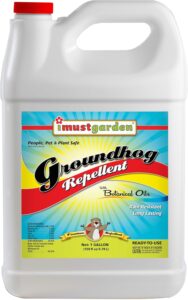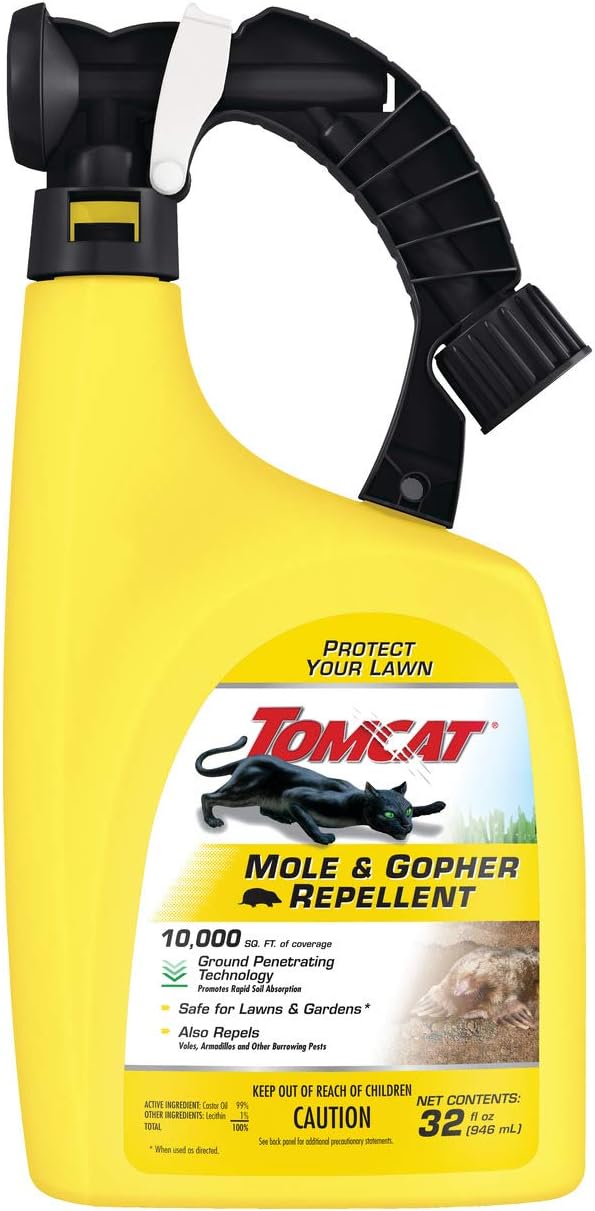Groundhog Control & Removal
Groundhogs (woodchucks) are large rodents whose burrowing and feeding habits can cause significant damage to gardens, lawns, and structures. While they play a role in natural ecosystems, their extensive burrow systems can undermine foundations and create hazards on properties. Understanding their behavior patterns is essential for implementing effective, humane control measures.
Recommended Products
Tomcat Mole & Gopher Repellent
A ready-to-spray repellent featuring Ground Penetrating Technology that helps castor oil penetrate deep into soil to deter burrowing pests. One 32 oz bottle treats up to 10,000 sq. ft. of lawn and garden space.
- Deep Penetrating Formula
- Wide Coverage Area
- Lawn Safe Application
- Seasonal Protection
CritterTec Solar Mole Repellent Stakes
Humane solar-powered stakes that emit sonic waves and vibrations to deter burrowing pests from your yard. Each set covers up to 5000 sq.ft with eco-friendly, continuous protection for up to 7 days on a full charge.
- Solar Powered
- Wide Coverage
- Weather Resistant
- Pet-Safe Operation
Motrapso Mole Repellent Packets
A humane essential oil-based repellent system that deters multiple burrowing pests without causing harm. Each individually sealed packet provides up to 3 months of protection with a natural scent that makes areas inhospitable to unwanted visitors.
- Essential Oil Formula
- Humane Solution
- Long-Lasting Protection
- Multi-Pest Defense
⚠️ Health & Safety Risks
- Foundation damage
- Structural undermining
- Garden destruction
- Trip hazards from holes
- Equipment damage risks
🚨 When to Call a Professional
- Multiple burrow systems
- Structural concerns
- Failed DIY attempts
- Legal removal requirements
- Property line issues
🏥 Emergency Response
- Ground collapse: Mark and fill holes
- Foundation issues: Contact engineer
- Utility damage: Call service provider
- Injury from holes: Seek medical care
- Property damage: Document for insurance
🏡 DIY Removal Guides

Best Groundhog Traps: Complete Guide to Humane Capture & Removal
Struggling with groundhogs destroying your garden or property? Our comprehensive guide reviews the best groundhog traps available, providing expert advice…
Read More →🛑 Prevention Tips

8 Best Groundhog Repellents & Deterrents: Expert Guide
Dealing with a groundhog problem? We’ve researched and tested the most effective groundhog repellents and deterrents to help you protect…
Read More →🔬 Professional Solutions & Products

How to Get Rid of Groundhogs Humanely: 7 Effective Methods
Dealing with groundhogs on your property? These burrowing rodents can cause significant damage to gardens, lawns, and even structural foundations.…
Read More →🦫 Related Pests
Similar damage from:
🔍 Signs of Activity
- Large burrow entrances
- Mounded dirt piles
- Vegetation damage
- Worn paths in grass
- Early morning activity
🏠 Common Areas
- Field edges
- Garden perimeters
- Under structures
- Near foundations
- Embankments
Frequently Asked Questions
How do I know if I have groundhogs?
Look for large burrow entrances (10-12 inches wide), mounded dirt, eaten vegetation, and early morning activity. Groundhogs are often visible during daylight hours.
What attracts groundhogs to my yard?
Vegetable gardens, fruit trees, soft soil for burrowing, and safe cover like brush piles or structures attract groundhogs. They prefer areas with good visibility.
How deep do groundhogs dig?
Groundhog burrows typically extend 2-6 feet deep and can be 15-25 feet long, with multiple chambers and entrances. This extensive digging can cause structural problems.
Do repellents work on groundhogs?
Commercial repellents provide temporary results. Long-term control requires exclusion methods, habitat modification, and possibly professional removal.
How do I protect my garden?
Install fencing at least 3 feet high with an additional foot buried underground and bent outward. Remove attractive vegetation near burrows.
Are groundhogs dangerous?
Groundhogs typically avoid human contact but may defend their burrows if cornered. Their primary impact is property damage rather than direct threats.
When are groundhogs most active?
Groundhogs are most active in early morning and late afternoon during spring through fall. They hibernate during winter months.
Will filling holes work?
Simply filling holes rarely solves the problem. Groundhogs will often re-excavate or create new burrows unless the underlying attractants are addressed.
Can I trap groundhogs?
Check local regulations before attempting to trap. Many areas require permits or professional removal. Humane trapping and relocation may be restricted.
How long does control take?
Initial control measures typically take 2-3 weeks to implement, but complete resolution may require ongoing monitoring and maintenance throughout the active season.


